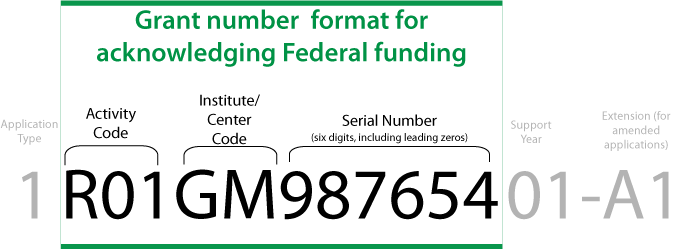Acknowledging your funding is a good practice of responsible conduct of research, a requirement of receiving the funding and a critical step to help demonstrate the impact of funding to policymakers and taxpayers.
It is important to be consistent when acknowledging grant-funding sources, especially for NIH Public Access Compliance.
Here are some tips that can help:
1. Use the Proper Grant Number Format. You need to include the Activity Code, Institute/Center Code and Serial Number. You do not need the support year or extension information.
Proper Grant Number Format:
Image from https://grants.nih.gov/grants/acknow.htm
2. Provide your award number and acknowledgment text to trainees and fellows. The PI or administrative support staff can provide the acknowledgment text to use for papers. We have seen and encourage grant acknowledgments on websites, email signatures, laminated cards and magnets. (We have not seen the information on fleece jackets yet.) Get creative and get the word out to your trainees.Check out the CRTC’s website for some examples: https://crtc.wustl.edu/resources/grant-citations/
3. Keep your grant funding acknowledgment information handy in your writing workflow. Create a file with your grant acknowledgment text and put it in the system(s) that you use for writing and communicating with coauthors – whether that is a manuscript template in Word, Google Docs, Outlook or another platform. While you are at it, include your preferred author name, affiliation and ORCID ID in this file. This makes it easy to start each manuscript with the information you need. You can also easily send this info to coauthors when they ask.
4. Remind your coauthors to check their acknowledgments. Researchers help other researchers acknowledge their funding. Gentle reminders to your coauthors to check and make sure the acknowledgments are correct can help ensure that no funding awards are omitted from the paper.
If you need help with your compliance plan or want to schedule a training, please contact Cathy Sarli or Amy Suiter.
For more information, see our NIH Public Access Policy subject guide.

